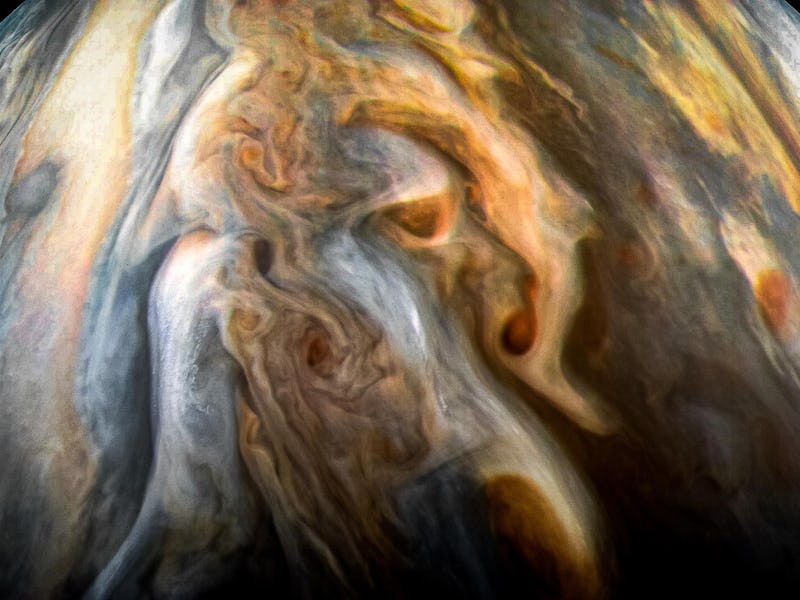NASA's Juno corrects a 25-year-old misconception about Jupiter
The gas giant's atmosphere contains way more water than scientists previously thought.

Some 4.5 billion years ago, gravity pulled swirling gas and dust together to form a giant planet more than twice as massive as all other planets in the Solar System — Jupiter.
And, unlike the other planets, Jupiter formed from the leftover material that created the Sun. Shrouded in its gaseous layers are secrets of the Solar System's earliest years. Now, new data from NASA's Juno mission to study the planet reveal just how little we really know about this iconic giant. Turns out that on one crucial point — whether Jupiter's atmosphere contains water — we have been dead wrong for decades.
In a study published this week in the journal Nature Astronomy, scientists reveal the most-accurate measurements of the water in Jupiter's atmosphere ever taken. The data come from NASA's Juno satellite, which began to study the planet in 2016.
For 25 years, scientists believed that water was very scarce in Jupiter's atmosphere — even less than the amount of water in the Sun’s atmosphere. But the new measurements put paid to those assumptions, showing that, far from being scarce, Jupiter has three times as much water in its atmosphere as the Sun.
"Just when we think we have things figured out, Jupiter reminds us how much we still have to learn," Scott Bolton, Juno's principal investigator at the Southwest Research Institute in San Antonio, said in a statement.
In the new observations, Juno's cameras captured images of Jupiter's equatorial zone with its thick white clouds.
Cracking the mystery of how much water truly exists in Jupiter’s atmosphere could provide a rare glimpse at the conditions in the Solar System during its earliest years.
Water world
As it orbits Jupiter, Juno looks for water in the planet’s atmosphere by tracing oxygen and hydrogen molecules. Based on Juno's data, water makes up around 0.25 percent of the molecules in Jupiter’s atmosphere. That is almost three times the amount of water in the Sun’s atmosphere.
The data clear up a conundrum in Jupiter's origin story: Earlier measurements suggested that water was largely missing from Jupiter's atmosphere — which ran contrary to theories about how the planet formed.
Hydrogen and helium are the most common elements in Jupiter, followed by oxygen. Scientists believe that oxygen may have been the primary evaporating gas of the protoplanetary disk, which is a rotating disk of gas and dust that surrounds a newly formed star. As a result, Jupiter should have at least some water in its atmosphere.
But in 1995, data from NASA’s Galileo mission to Jupiter suggested the planet's atmosphere contained 10 times less water than expected.
Stormy planet
This wasn't the only problem with the old data — the amount of water in Jupiter's atmosphere also controls its weather.
In March, 1979, NASA’s Voyager 1 spacecraft flew by Jupiter, detecting a strange, Earth-like phenomenon — lightning.
For there to be lightning on a planet, there needs to be an abundance of water in its atmosphere. Other key characteristics of Jupiter’s meteorology also rely on water, such as its powerful storms.
Jupiter’s famous Great Red Spot is the largest storm of its kind in the entire Solar System. It has been raging on for years. The winds on Jupiter can reach up to 335 miles per hour, according to NASA.
Jupiter's Giant Red Spot storm has been observed for the past 300 years.
In addition, the lines that seem to swirl around the giant planet are thought to be cold, windy clouds of ammonia and water.
Enter, Juno
Juno launched in 2011. One of the mission’s main objectives is to determine how much water is in Jupiter’s atmosphere. Doing so will give scientists a better understanding of how planets formed early on in the Solar System.
Juno has been orbiting Jupiter since 2016.
The spacecraft orbits Jupiter every 53 days, using its Microwave Radiometer instrument to observe the planet from above. The tool features six antennas that measure atmospheric temperature at multiple depths simultaneously. Because both water and ammonia absorb microwave radiation, these temperature measurements show their abundance in Jupiter’s atmosphere.
These most-recent — and revealing — measurements were conducted at Jupiter’s equator. It is a unique region to the planet that may have its own distinct weather and atmospheric features, so further measurements are needed in order to determine whether they apply to the planet as a whole.
Juno has been a game-changer for astronomers studying the giant planet. Among its recent findings have been the first views of Jupiter's moon Ganymede's north pole, and documenting a particularly chaotic region of the planet's storms, suggesting that wind systems similar to those found on Earth run deeper and last longer on Jupiter than they do on our own planet.